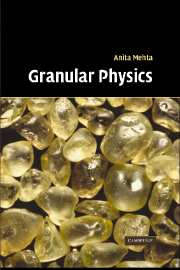Book contents
- Frontmatter
- Contents
- Preface
- 1 Introduction
- 2 Computer simulation approaches – an overview
- 3 Structure of vibrated powders – numerical results
- 4 Collective structures in sand – the phenomenon of bridging
- 5 On angles of repose: bistability and collapse
- 6 Compaction of disordered grains in the jamming limit: sand on random graphs
- 7 Shaking a box of sand I – a simple lattice model
- 8 Shaking a box of sand II – at the jamming limit, when shape matters!
- 9 Avalanches with reorganising grains
- 10 From earthquakes to sandpiles – stick–slip motion
- 11 Coupled continuum equations: the dynamics of sandpile surfaces
- 12 Theory of rapid granular flows
- 13 The thermodynamics of granular materials
- 14 Static properties of granular materials
- References
- Index
- Plate section
11 - Coupled continuum equations: the dynamics of sandpile surfaces
Published online by Cambridge University Press: 06 October 2009
- Frontmatter
- Contents
- Preface
- 1 Introduction
- 2 Computer simulation approaches – an overview
- 3 Structure of vibrated powders – numerical results
- 4 Collective structures in sand – the phenomenon of bridging
- 5 On angles of repose: bistability and collapse
- 6 Compaction of disordered grains in the jamming limit: sand on random graphs
- 7 Shaking a box of sand I – a simple lattice model
- 8 Shaking a box of sand II – at the jamming limit, when shape matters!
- 9 Avalanches with reorganising grains
- 10 From earthquakes to sandpiles – stick–slip motion
- 11 Coupled continuum equations: the dynamics of sandpile surfaces
- 12 Theory of rapid granular flows
- 13 The thermodynamics of granular materials
- 14 Static properties of granular materials
- References
- Index
- Plate section
Summary
Introduction
Some general remarks
The two previous chapters have dealt, in different guises, with the post-avalanche smoothing of a sandpile which is expected to happen in nature. It is clear what happens physically: an avalanche provides a means of shaving off roughness from the surface of a sandpile by transferring grains from bumps to available voids, and thus leaves in its wake a smoother surface. However, surprisingly little research has been done on this phenomenon so far, despite its ubiquity in nature, ranging from snow to rock avalanches.
In particular, what has not attracted enough attention in the literature is the qualitative difference between the situations which obtain when sandpiles exhibit intermittent and continuous avalanches. In this chapter we examine both the latter situations, via coupled continuum equations of sandpile surfaces. These were originally envisaged as the local version of coupled equations that had been written down using global variables in; subsequently, many versions were introduced in the literature to model different situations. The use of these equations has also since been diversified into many areas, including ripple formation and the propagation of sand dunes, about which we will have something to say at the end of this chapter.
In order to discuss this, we introduce first the notion that granular dynamics is well described by the competition between the dynamics of grains moving independently of each other and that of their collective motion within clusters.
- Type
- Chapter
- Information
- Granular Physics , pp. 148 - 175Publisher: Cambridge University PressPrint publication year: 2007



